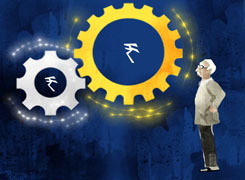SBI PSU Fund - Direct G: What should I do?
Ramalingam Kalirajan |10874 Answers |Ask -Follow
Mutual Funds, Financial Planning Expert - Answered on Mar 04, 2025
He has an MBA in finance from the University of Madras and is a certified financial planner.
He is the director and chief financial planner at Holistic Investment, a Chennai-based firm that offers financial planning and wealth management advice.... more

How SBI PSU fund - Direct G
Let’s analyse their advantages, risks, tax impact, and suitability.
Advantages of Public Sector Mutual Funds
Growth Potential
Many government-owned companies dominate their sectors. They benefit from policy support and large-scale projects. This can drive long-term growth.
Dividend Income
Public sector companies often pay regular dividends. This can provide steady cash flow for investors.
Policy Support
Government-owned firms receive policy benefits. They get subsidies, contracts, and regulatory support. This reduces business risks.
Value Investing Opportunity
These stocks often trade at lower valuations. This can offer long-term value investment potential.
Sector-Specific Exposure
Investors can get targeted exposure to sectors like banking and energy. This can be useful if these sectors grow rapidly.
Risks in Public Sector Mutual Funds
Government Influence
These companies follow government decisions. This may not always align with shareholder interest.
Limited Growth in Some Sectors
Some public sector firms have low innovation. Their revenue growth may be slower than private firms.
High Volatility
Market reactions to government policies affect public sector stocks. This can increase fund volatility.
Debt and Capital Efficiency Issues
Many public sector firms have high debt. Their capital use is often inefficient. This can affect returns.
Economic and Political Impact
Economic downturns and political changes impact these funds. Their performance depends on government spending.
Who Should Invest in These Funds?
Investors with a Long-Term Horizon
These funds may need time to deliver strong returns. Patience is required.
Those Seeking High Dividend Yield
Investors looking for dividend income may find them useful.
People Comfortable with Government Exposure
If you trust government-backed firms, these funds may suit you.
Investors Who Understand Risks
You must be aware of economic and political risks.
Taxation Impact on Public Sector Mutual Funds
Long-Term Capital Gains (LTCG) Tax
Gains above Rs 1.25 lakh are taxed at 12.5%.
Short-Term Capital Gains (STCG) Tax
Gains are taxed at 20% if sold within one year.
Dividend Taxation
Dividends are added to your income and taxed as per your slab.
Direct vs Regular Funds: Which is Better?
Direct Funds Have Hidden Disadvantages
Many investors choose direct funds to save on commission. But this can lead to mistakes.
Lack of Expert Guidance
Investors often lack financial expertise. A Certified Financial Planner (CFP) can help you select the right fund.
Emotional Investing Risks
Many direct fund investors panic during market crashes. A CFP helps you stay invested.
Wrong Asset Allocation
Direct investors may choose funds without a clear strategy. This can hurt long-term returns.
Regular Funds Provide Better Portfolio Management
Investing through a CFP ensures disciplined investing. They also review and rebalance your portfolio.
How to Approach Public Sector Mutual Funds?
Understand Your Risk Profile
These funds have sector-specific risks. Check if they match your risk tolerance.
Diversification is Key
Don’t put all your money into one sector. A balanced portfolio is better.
Invest for the Long Term
Short-term volatility is high. A long investment period helps reduce risks.
Avoid Emotional Reactions
Public sector funds react to government policies. Stay invested without panic selling.
Seek Professional Advice
A CFP can help you decide if these funds fit your portfolio.
Final Insights
Public sector mutual funds offer high growth potential.
They also come with policy risks and volatility.
These funds suit long-term investors comfortable with government influence.
Tax efficiency depends on your holding period.
A CFP can help you optimise returns and manage risks.
Best Regards,
K. Ramalingam, MBA, CFP,
Chief Financial Planner,
www.holisticinvestment.in
https://www.youtube.com/@HolisticInvestment
You may like to see similar questions and answers below
Ramalingam Kalirajan |10874 Answers |Ask -Follow
Mutual Funds, Financial Planning Expert - Answered on Jun 06, 2024
Ramalingam Kalirajan |10874 Answers |Ask -Follow
Mutual Funds, Financial Planning Expert - Answered on Aug 03, 2024
Ramalingam Kalirajan |10874 Answers |Ask -Follow
Mutual Funds, Financial Planning Expert - Answered on Oct 30, 2025
Mayank Chandel |2569 Answers |Ask -Follow
IIT-JEE, NEET-UG, SAT, CLAT, CA, CS Exam Expert - Answered on Dec 08, 2025
Mayank Chandel |2569 Answers |Ask -Follow
IIT-JEE, NEET-UG, SAT, CLAT, CA, CS Exam Expert - Answered on Dec 08, 2025

Mayank Chandel |2569 Answers |Ask -Follow
IIT-JEE, NEET-UG, SAT, CLAT, CA, CS Exam Expert - Answered on Dec 08, 2025
Mayank Chandel |2569 Answers |Ask -Follow
IIT-JEE, NEET-UG, SAT, CLAT, CA, CS Exam Expert - Answered on Dec 08, 2025
Mayank Chandel |2569 Answers |Ask -Follow
IIT-JEE, NEET-UG, SAT, CLAT, CA, CS Exam Expert - Answered on Dec 08, 2025
Anu Krishna |1746 Answers |Ask -Follow
Relationships Expert, Mind Coach - Answered on Dec 08, 2025
Ramalingam Kalirajan |10874 Answers |Ask -Follow
Mutual Funds, Financial Planning Expert - Answered on Dec 08, 2025
Samraat Jadhav |2499 Answers |Ask -Follow
Stock Market Expert - Answered on Dec 08, 2025
Ramalingam Kalirajan |10874 Answers |Ask -Follow
Mutual Funds, Financial Planning Expert - Answered on Dec 08, 2025
Radheshyam Zanwar |6737 Answers |Ask -Follow
MHT-CET, IIT-JEE, NEET-UG Expert - Answered on Dec 08, 2025























